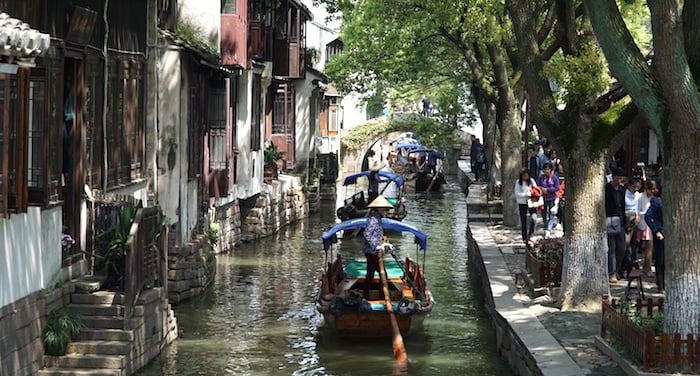 A glimpse of the canals of Tongli – Photo by Matteo Bosi
A glimpse of the canals of Tongli – Photo by Matteo Bosi
A thriving region in the east of Great China, Jiangsu is in the history books for the fundamental events that belong both to Imperial China and that of the republic. Various dynasties have chosen this central area for their capital; but when Sun Yat-Sen named Nanjing the capital of the republic for the thirty years that it lasted, and sadder still, after the famous Rape of Nanking, Jiangsu entered into modern history.
The region is currently among the richest and most developed; because of this, it’s the destination for migrants and internal movements of the poorer bordering regions, such as Anhui. Just think in terms of dimensions – it’s the smallest region but most densely populated of them all.
The capital city of Jiangsu is Nanjing. Shanghai was once included in part of the territory until its independence at the beginning of the last century; actually the recent history of Shanghai differs much from that of Jiangsu. However, the metropolis’s influence has helped the southern part of the region to increase economically and in terms of tourism: Suzhou is the surrounding area that most benefits from its vicinity to Shanghai.
Of all the characteristics of this province, the most noteworthy is certainly the massive presence of water. Not only does the infinite Yangtze flow right through Jiangsu, Shanghai and Zhejiang, in its enormous delta, but there are also several lakes.
And obviously, the eastern coast faces the sea. This abundance of aquatic resources has resulted in…rice and fish, a staple of the local diet. It has also earned the title of 水乡 (shuǐxiāng “land of water”), especially when referring to Suzhou and its surrounding towns as the Venice of the East.
Today, while still a land of fishermen and farmers, which are fundamental economies to maintain the big cities, IT and heavy industries are widespread. This at the cost of the cleanliness of the air and water aquifers.
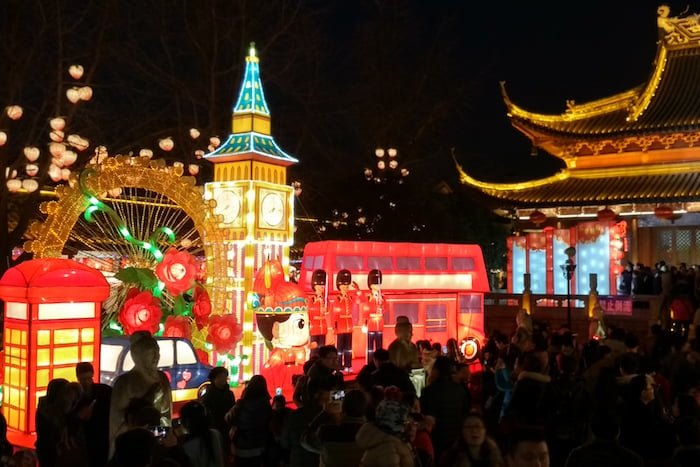 The Fuzimiao neighborhood in Nanjing during the Festival of the Lanterns – Photo by Matteo Bosi
The Fuzimiao neighborhood in Nanjing during the Festival of the Lanterns – Photo by Matteo Bosi
Why visit Jiangsu
If you’re looking for the China of ethnic diversity and genuine traditions, then perhaps this isn’t the best place. It is the place for those wanting to come into contact with cutting edge China, which runs swiftly along the highway of change – the one wherein a few years everything changes and little villages become modern cities.
Here you can appreciate a rich and efficient lifestyle that’s still cheap; you’ll find luxury hotels and spas, perfectly functioning transportation connections, and exaggeratedly large museums.
Next to this, a historic glow survives, especially between Nanjing and Suzhou, which you’ll want to see: check out our specific guide to the city for a better idea.
Other than its services, remember what I said – it’s a very crowded place: so the traffic and people are a common denominator that you’ll have to get used to quickly. Personal distances vary, the rules of the road are more easily determined by the number of cars, pedestrians, and bikes throughout the city. So don’t be too surprised, nor expect to find the same customs as back home, since the habits are (culturally) different; so tolerance and an open mind is the best strategy.
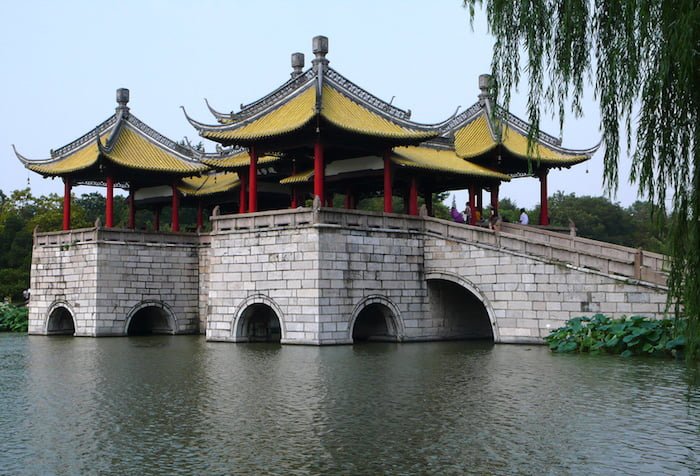 A Bridge on Yangzhou Slender West Lake –
A Bridge on Yangzhou Slender West Lake – ![]() Five Pavilion Bridge by drumbrake (2)
Five Pavilion Bridge by drumbrake (2)
How to get to and around Jiangsu
Transportation connections are absolutely a strong point for the region. That’s not just for air connections, but also for high-speed rail: a fundamental section of the north-south route passes through here (Beijing-Shanghai).
- Air: the best international airport is in Nanjing, with direct flights from Europe and Milan; other towns have smaller airports where local traffic is more frequent (Changzhou, Yangzhou or Nantong for example). But its proximity to Shanghai allows you to fly into this central hub and get to Jiangsu at high speed.
- Train: the high-speed line connects different centers in Jiangsu, not just the basic historic axis of Nanjing-Suzhou-Shanghai: or Kunshan, Wuxi, Changzhou, Danyang, and Zhenjiang. The intercity and express trains cover the rest of the territory, to the extent that the rail network is among the most efficient and cutting edge in China.
- Auto: since the region is generally flat, the road network developed quickly. Literally, you can travel through with the same agility as getting around Italy by car. That doesn’t go for city traffic – unfortunately!
The cities are all connected by fast-moving highways with three/four lanes. And the Yangtze which cuts the region in two counts a good 11 bridges that cross it, among which are some of the most imposing suspension constructions in the world. Plus the various tunnels.
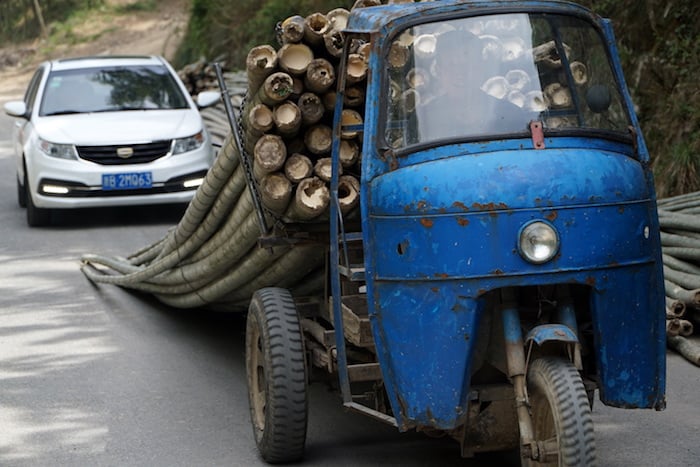 Bamboo is everywhere in Jiangsu and this is one of the ways it’s transported from the forests to the companies that work with it – Photo by Matteo Bosi
Bamboo is everywhere in Jiangsu and this is one of the ways it’s transported from the forests to the companies that work with it – Photo by Matteo Bosi
- Ship: yes, that’s an option too. Because, as I said above, there’s an abundance of water, so cruises on the Yangtze or tours from the port of Suzhou are an interesting attraction for visiting the river landscape. First of all, I recommend that you avoid coming in winter since it’s very gray and cloudy here and you risk traveling from one place to another without being able to appreciate any of the scenery. In addition, the main artery of the Yangtze is by now used for commercial purposes and its shorelines don’t have much scenery to offer. Something more interesting can be found by following the Grand Canal. But if you could choose, I personally think the only boats that are worth it are the pleasant “gondolas” that go through the canals of Suzhou and the surrounding towns.
- Bicycle: since it’s a gently level and vaguely hilly region, cycle tourism is starting to take hold. The larger cities can all be explored by bike, such as the historic center of Nanjing, and there are several trips leading out of the city towards the peripheries to tended lakes and towns that are still “genuine”.
What nice things are there to see in Jiangsu?
Cities
The main cultural centers are also the largest cities. Not just from a historical point of view, but also for example regarding local classical opera or gastronomy.
First of all the biggest city, Nanjing (南京 or Nanking), where you can still find traces of its imperial past: such as the city wall from the Ming era (which is rebuilt today), in the imperial buildings and the historic site atop the hill that looks over the city, Purple Mountain (紫金山). In Nanjing you can attend a Kunqu opera show, a local variation of the Beijing Opera near the Chaotian Palace (朝天宫), which is also the site of a history museum.
However the most famous part of Jiangsu remains Suzhou (苏州) with its neighboring towns such as Tongli (同理) and Zhouzhuang (周庄). Suzhou’s gardens have been recognized as a World Heritage Site and are absolutely not to be missed: to mention just one, The Garden of the Humble Administrator (拙政园) is a place of extraordinary decorative perfection, peace and deep cultural identity. The inside of the city’s historic center is tinged by a network of canals crossed by little bridges facing houses with traditional architecture. Even though it’s very popular, it still preserves the same magical atmosphere of the past. Here too you can come across Kunqu opera: the last time I was in the small and well-preserved theater, rehearsals were in session and several ladies were having their makeup done so they could take pictures in traditional operatic style. It’s very evocative.
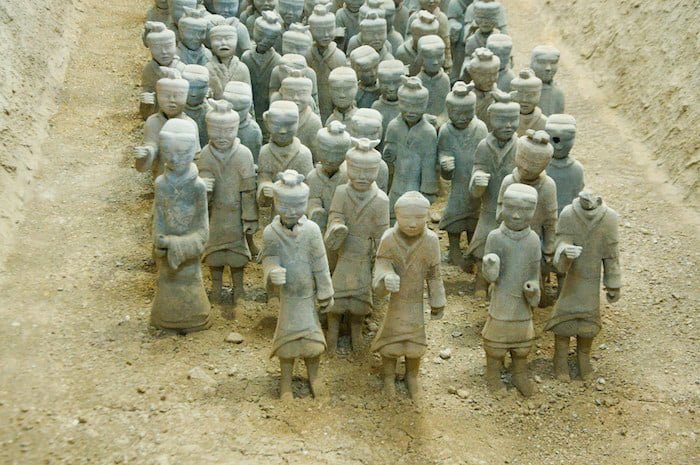 A detail of the Xuzhou Terracotta Army –
A detail of the Xuzhou Terracotta Army – ![]() Xuzhou, Dec-2015 by Mitch Altman
Xuzhou, Dec-2015 by Mitch Altman
Xuzhou (徐州) is actually the oldest town and extends to the north of Jiangsu. The main attraction, which is sadly little-known, is the Terracotta Army of the Han Dynasty (龟山汉墓). It’s a miniature of the more famous army in Xi’an, but just as fascinating. Xuzhou was at the center of several events in modern China’s history from the Second Sino-Japanese War to the Civil War. Before this it’s name was tied to the Grand Canal, a work of extraordinary imperial engineering, and was the cradle of Han culture that’s still quite present.
Yangzhuo (扬州) is a big city not far from the capital city Nanking, which makes for an easy day trip. People visit Yangzhouto see the Park of the Little Western Lake (瘦西湖公园) or the gardens. In the past the city was ruled by Marco Polo for a time (a city Memorial is dedicated to him), and its prosperity is due to its position between the Grand Canal and the Yangtze. There’s not much left that gives witness to the past, but you can include a visit to the center with the Daming Monastery(大明寺) just outside the Tombs of King and Queen Guangling (汉广陵王幕).
I lastly cite Wuxi among the major cities: it’s a rather industrial city, but it hosts one of the tallest Buddha statues in China near Mount Ling (灵山). Wuxi is surrounded by water, with the Yangtze to the north and on the south the shores of one of the biggest lakes in Jiangsu, Lake Tai (太湖). This brings me to list the lakes and bodies of water of Jiangsu.
Bodies of water
It’s very hard to find them listed among the main attractions, but the lakes and ponds all have their own system of services for classic tours outside the city heading for the countryside. In essence, the Chinese love to escape the chaos of the city for a few days and find themselves pampered in luxurious hot springs, amusement parks where they offer watersports (canoes for example) or bamboo forests where they can walk through the greenery or ride horseback. In addition, when Spring draws near, the blossoms are a huge Oriental attraction and that’s what you’ll see – people convulsively taking pictures everywhere in this very humid continental climate.
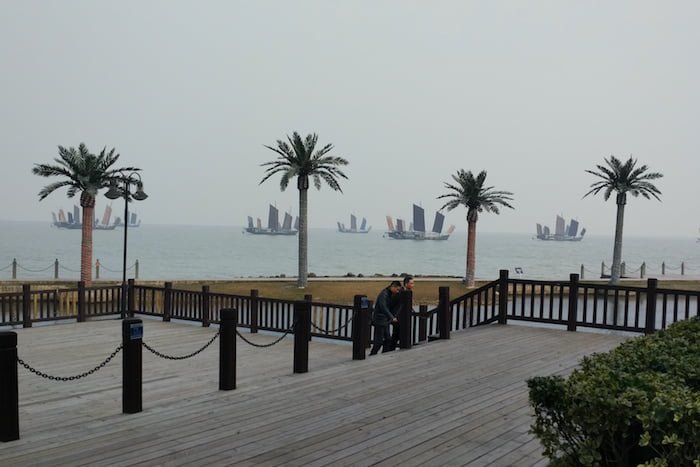 Lake Tai on a not too clear day- Photo by Matteo Bosi
Lake Tai on a not too clear day- Photo by Matteo Bosi
- Lake Tai (Taihu 太湖): is one of the most extensive lakes in China. Turtle Head Island (鼋头渚) is one of the main attractions, which can be reached from Wuxi and is best visited in the Spring during the cherry blossoms: there are more than 50 species. Lake Taihu is an enormous basin. When traveling near the lake by car, it seems as if you’re riding along the coast of the sea. On the shores of the lake, there are also numerous trails for both easy and challenging hikes and “little villages” for brief experiences of rural China and local gastronomy.
- An example of smaller lakes: Lake Tianmu (天目湖) is located a few hours away by car from Changzhou. On its banks are hotels that offer non-natural hot springs, but as is often the case in China, enriched by Chinese medicine. To say it improperly, a hot bath in tea. Each tub has its own owner and temperature, and you need to carefully choose which one to immerse yourself in since not all are suitable for the physical needs of each individual. At the lake, a peninsula has become a natural park for families and you can admire the squirrels rather than the butterflies.
Near Lake Tianmu, there’s the tourist area of Nanshan (南山), famous for its bamboo forest; here you can also see some examples of pandas.
- Lake Luoma (骆马湖): this is one of those areas where, if you have time to spare, you can track down and still capture some of traditional China. From the town of Suqian, you’ll reach a marshy area full of birdlife. The lake seems small compared to nearby Hongze (洪泽湖) and Gaoyou (高邮湖), but it decisively isn’t, so don’t think about the refreshing trail around the lake!
- An even smaller lake: Lake Bailu (白鹭湖), an hour south of Nanjing, is a demonstration of how around many medium-sized lakes many family-oriented activities are organized. Canoeing, game parks, horseback riding. A pleasant tour outside.
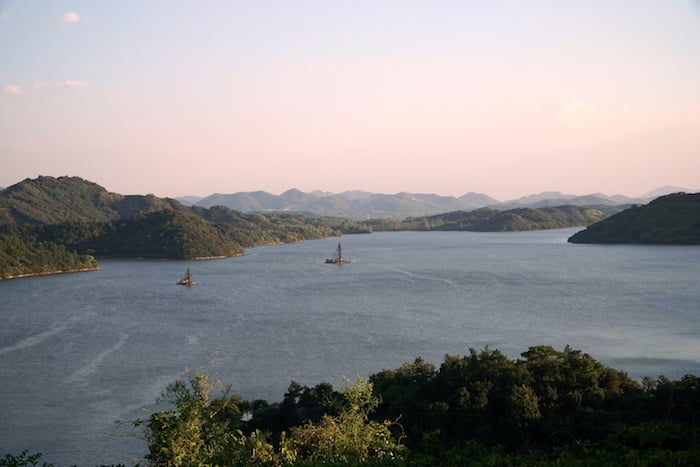 A panorama from above Tianmu – Photo by Matteo Bosi
A panorama from above Tianmu – Photo by Matteo Bosi
Mountains
I promise that this is not a chain of dizzying heights, but rather pleasantly sloped hills, often covered by tea plants or tall bamboo plants that make for a truly typical landscape in these areas.
In Nanjing you can find one of the most important Buddhist places of worship in the region, the Qixia Temple(栖霞寺) which is on top of the mountaintop of the same name. Other than religious pilgrims, the zone is famous for its path along the Cliff of the Thousand Buddhas: small lodgings carved in the caves that host little statues of Buddha in the prayer which during the Cultural Revolution had their heads taken off. Decide for yourself if it’s an interesting witness to China’s recent past or a philological massacre…
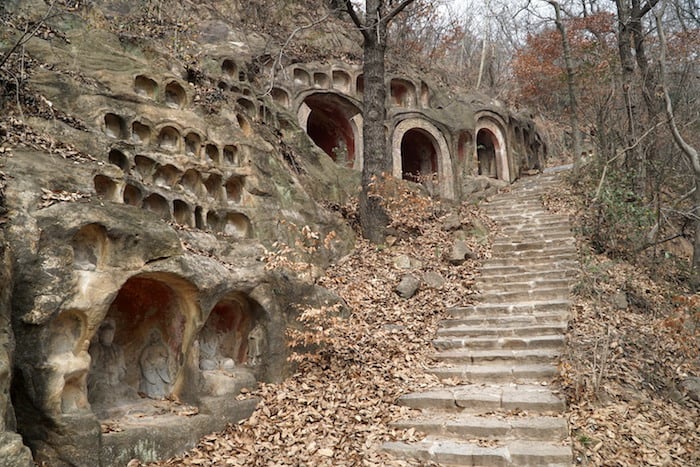 The Cliff of the Thousand Buddhas in Qixiashan -Photo by Matteo Bosi
The Cliff of the Thousand Buddhas in Qixiashan -Photo by Matteo Bosi
Moreover, it’s a favored destination for shoulder seasons, or during the time when flowers bloom or the leaves turn color. Qixia can be reached by bus from Nanjing in about an hour from the north station. Or more quickly by taxi.
Recently another area has become famous, rebuilt to give value to Usnisa artifacts found in Nanking. This is the site of Niushou Shan (牛首山), a park that includes a modern impressionist temple: first for its imposing architecture, which at the time of writing was still being worked on; and then for the scenic effects of light and movement on the statues within the temple. Next to the main building of the temple, a pagoda and a park that requires a map to be visited. The intent is to offer a vacation place in addition to a place of worship. From the city, a taxi is the quickest option to get to Niushou Shan.
Still in Nanjing, one of the most unanimously appreciated destinations is Tangshan (汤山), half-hour by car from the city. Here you’ll find the best hot springs nearest the metropolis with various options for all budgets and needs. Usually you stay in one of the thermal structures and spend two days between hot baths, effective massage scrubs, being buried under hot sand (tirelessly operated by subjects equipped with shovels), hot stone treatments, and liters and liters of tea for free. There are buildings that also host families with little children, but obviously not too little since the tubs are never less than 38°.
In the north of Jiangsu you can also find one of the highest “peaks” in Jiangsu, Mount Huaguo (花果山): it’s about 600 meters… Famous for being the center of the classic novel Journey to the West, where the famous character of the Monkey King (Sun Wukong) was found, reportedly in vogue in the literary tradition on the screen in various successful sagas. Actually, it’s not a very difficult walk, which is obviously surrounded by the indigenous monkeys.
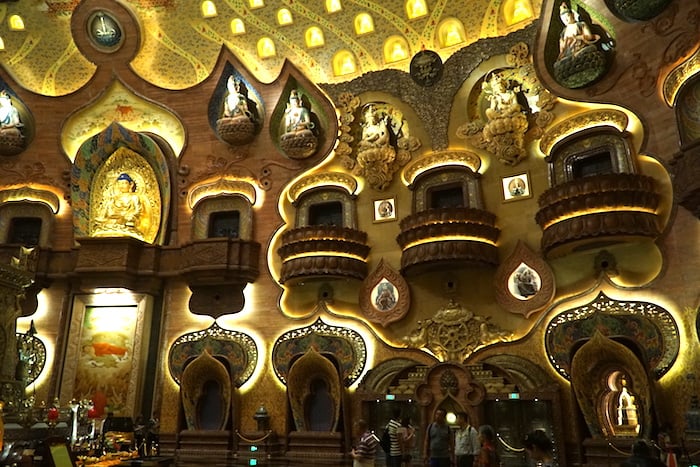 The inside of the main temple in Niushoushan – Photo by Matteo Bosi
The inside of the main temple in Niushoushan – Photo by Matteo Bosi
In Zhenjiang (镇江) there are the famous three hills that surround the city: Jinshan (金山), Jiaoshan (焦山) and Beigu (北固山). Of the three, the last one is the least touristy. They are widely punctuated by temples big and small and offer panoramas of the city on clear days.
Nantong (南通) too has its escape from the chaos: it’s called Wolf Mountain (狼山) and its highest peak is Foshan (佛山). It’s a very well-cared-for area that offers a view over the city and the option of walking in silence – as the crowd allows.
What to know about the local culture
First of all, keep in mind that the suggestions given in this guide are not exhaustive. It wasn’t possible for me to gather all the sites of interest that the inhabitants are proud of and advertise sensationally. You’ll quickly realize that the classifications used at the tourist sites are not very trustworthy because the range of evaluation varies widely and is rather spent on promoting local heritage.
So if the historic or tourist sites are graded with five uppercase A’s, then it’s just ok. With this I’m not saying that the national classification should be ignored, but let’s just say that UNESCO is much more thorough. And above all, there are too many corners of the landscape conquered by official evaluation!!
Outside the main destinations, on your visit to Jiangsu, I definitely recommend that you take the time to see a kunqu opera: it’s really worth it and is the most musically and artistically fascinating that you can find in China; it isn’t for no reason that it made the list of oral world heritage.
You can visit the Suzhou Museum and the Pin Tan Theater where they hold examples; or as I said above, the little Chaotian Gong Theater in Nanking: every Saturday evening at 19.30 there’s a popular show composed of four extracts from other operas subtitled in English.
Besides the opera, allow yourself to be won over by the local cuisine: each city has its own main dish and cuisine, but the regional cuisine is known for being among the most famous in China. You won’t have to fight spiciness. I can briefly recommend that you taste the following dishes in the various areas:
- in Yangzhou the salted rice (扬州炒饭);
- in Suzhou and the surrounding towns, the freshwater fish is usually boiled with spices, but is notoriously full of bones so it takes more work to be eaten;
- in Zhozhuang they eat a very tasty version of caramelized pork shank;
- in Nanjing the tangbao are great (汤包) which are tortellini filled with pork that once steamed release a soup at volcanic temperatures: be careful, let the soup drain in the dish or spoon if you don’t want to burn yourself! To follow, there’s always the famous bowl of rice noodles in duck’s blood (鸭血粉丝汤), plus a varied series of snacks that you can find while walking though the famous Fuzimiao neighborhood (which is why they call them Fuzimiao snacks, 夫子庙小吃);
- while in Wuxi the local freshwater fish is quite renowned. For saltwater fish you should go to Nantong.
Happy travels and have fun exploring Jiangsu!
If you have any doubts I invite you to leave a comment below.
[Photo Credits (Creative Commons License): https://Mitch Altman, https:// MBChristensen, https://drumbrake]



